二か国語対応
Menu

Japanese only
Akizuno Links
Japanese only
 It is about ten minutes from Kitera by car. There is the farmer's restaurant, 'Mikan Batake' in Akizuno Garten. Local mothers make slow food lunch buffet with local fresh vegetables, and it is very popular. It is about ten minutes from Kitera by car. There is the farmer's restaurant, 'Mikan Batake' in Akizuno Garten. Local mothers make slow food lunch buffet with local fresh vegetables, and it is very popular.
It is also a reasonable price: An adult for 950 yen.
Open 11:30 to 14:00 on weekdays
11:00 to 14:00 on weekends and holidays
No reservation needed
TEL 0739-35-1199
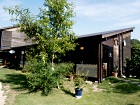
Akizuno Garten is completely equipped with facilities for staying.
You can use it as accommodation for green tourism, the entrance to Kumano Kodo, or for Nanaki Shirahama Onsen.
Booking at Akizuno Garten
TEL 0739-35-1199


|
『If you come to Kitera, why don’t you take a turn in the country
of Akizuno?
|
Please visit the country of Kitera in Akizuno with rich in nature and
history.
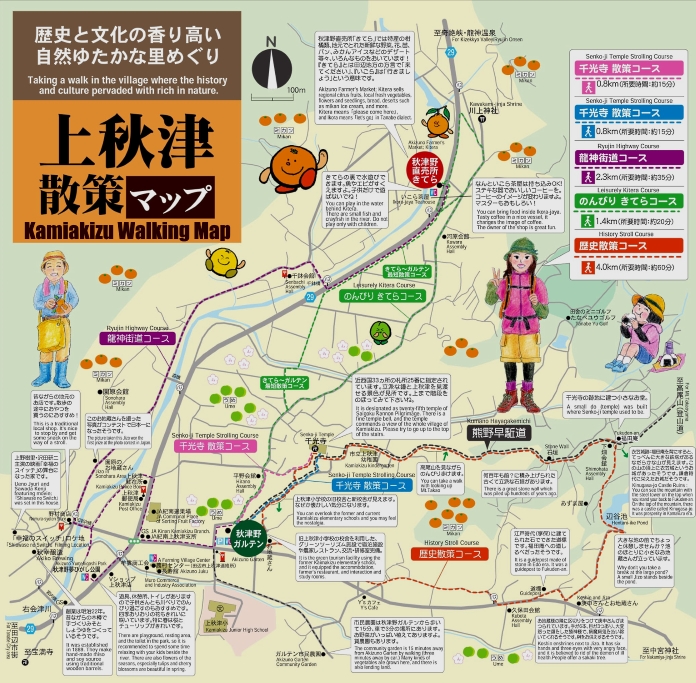
Click the illustration map to enlarge it.
printout(PDF) |
The country of Akizuno is blessed with nature, beauty spots, and
historic sites.
|

| Click the photo to enlarge it |
|
Kizekkyo
There are about 500 cherry trees in the ravine and people enjoy cherry
blossoms in spring. Also in early summer, dark green of trees sets your
mind at ease. Families visit there in summer to enjoy the cool breeze and
we can hear excited voices beside the river. It is also a base for hiking
to Mt. Takao-san, Mt. Mitsuboshi-yama, and Mt. ryujin-yama in fall, and
leave starts to turn red in late autumn and those leaves decollate vividly
the rock surface. |
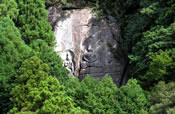
| Click the photo to enlarge it |
|
Magan Sanzon Daisekibutsu
Over the Fodo-no-taki Waterfall of Kizekkyo, there is one huge rock (height 16m, width 22m) with heavy-walled carving copying the original drawing of Domoto Insyo master painter. Amitabha Buddha in the center is height of 7.3 meters (half of Big Buddha in Nara,) and two bodhisattvas beside it (Mahasthamaprapta and Avalokitesvara) are height of 4.9 meters. |
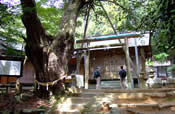
| Click the photo to enlarge it |
|
Mt. Ryuden-san 〜 Ryujin-gu Shrine
It is said that Kobo Daishi was in Ryujin-gu Shrine, the sacred place, which stood on 500 meter above on top of the mountain. Ubame oak is sacred tree and it lives about 400 years. It is very valuable as a living ubame oak individually and is designated as a national treasure in Tanabe city and Wakayama prefecture. |
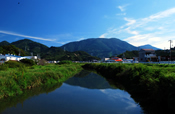
| Click the photo to enlarge it |
|
Mt. Takao
Mt. Takao is 606 meters above and can be seen from the whole Tanabe city, and it is popular among the citizen. Its view is majestic, and people climb up the mountain in the beginning of the year to see the sun rise. For the people visiting through the seasons, a toilet, lawn open space, and a log house are prepared near the top of the mountain. |
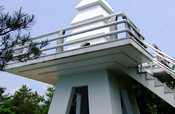
| Click the photo to enlarge it |
|
Mt. Takao Sutra Mound Monumental Tower
It was built for a monument of excavation of sutra mound at Mt. Takao on April 11, 1936. The present tower was rebuilt with the aid of residents in fall, 1988 after the old one naturally collapsed. |
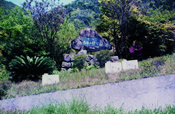
| Click the photo to enlarge it |
|
Terayashiki Ruin of Senko-ji temple and Sutra Mound
Ruined Senko-ji temple in Mt. Takao (Terayashiki ruin) was built by Waki Kiyomaro 1200 years ago to mourn for his precious hawk. It had complete seven-structured temple compound, and it was told that the principal image, Senju-kannon (Thousand Armed Avalokiteshwara,) was made by Gyoki Bodhisattva, and Atago Gongen was enshrined as the guardian god of a village.
Three sutra mound was excavated at Terayashiki Ruin by Nakayama Unhyo in 1931. Excavated ones such as mirror surface and ornament are preserved and exhibited in Tokyo National Museum. |
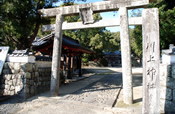
| Click the photo to enlarge it |
|
Kawakami-jinja Shrine
Nomura who lived in Nomura-go in Kawauchi-no-kuni, moved the sacred spirits of a god from Kwakami-jinja Shrine in Kawakami vllage in Saga to the present place and worship to those spirits. Enshrined deities are Seoritsu-hime, Hayaakitsu-hiko and Hayaakitsu-hime. Hayaakitsu-hiko and Hayaakitsu-hime are ancestors who found Akizuno.
There is a festival on November 23 every year. |

| Click the photo to enlarge it |
|
Ichikisima-jinja Shrine
Ichikishima-hime is deified in the shrine. It is also called Benten-san.
The shrine is in Shimohata area from old days, and when Aisu Suketoshi built Takanosu-jo castle, he worshiped the shrine for a tutelary deity. In 1585, the shrine prospered the most while the sovereign changed from Aisu to Sugiwaka by Hideyoshi’s attack of Kisyu. |
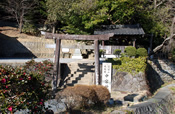
| Click the photo to enlarge it |
|
Nakamiya-jinja Shrine
It was built by the lord of Kinugasa Castle, and it used to stand on Nokubo area which was between Mt. Takao and Senko-ji temple, so it was called ‘Naka no Miya’ (Naka means between in Japanese.) Later, it was crashed because of the landslide and it lost a large land. The temporary shrine was built on the small land which was left from the landslide, but it was renewed in 1888, and a torii (gateway to a Shinto shrine) was added in 1928. It is told that the deity of the shrine is Izanami-no-Mikoto, and from ancient times, it was called Atago Gongen. Originally, Waki Kiyomaro transferred the divided deity from Kyoto. In Kyoto, Goo-jinja Shrine enshrined Kiyomaro and there was a tradition that Ujiko worshiped Goo-jinja Shrine, received the charm, and brought it back to Nakamiya-jinja Shrine. |

| Click the photo to enlarge it |
|
Iwagami-jinja Shrine
Going up about 300m along Sakodani (a small ravin,) there is Iwagami-jinja Shrine on left of the foot of the mountain. In Meiji era, it merged Tateiwa-myojin Shrine stood on the east. Moreover, it merged the small shrine in Okubohira. It was wrote down ‘the festival of deifying a huge rock as a god on November 5th’ in Kiizoku Fudoki. It was merged to Kawakami-jinja Shrine in Meiji era, but returned back to the present place. It enshrined Sukunahikona as a god of agriculture and medicine. |
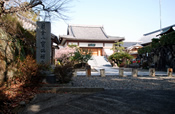
| Click the photo to enlarge it |
|
Homan-ji Temple
Shioya Yukihisa (a younger brother of Fujiwara Hidehira in Osyu) built the temple, and it was founded by Zessyo Osyo (a Buddhist priest). In 1585, it was burnt down by Hideyoshi’s attack of Kisyu. After that, it was rebuilt in 1590’s. It belongs to Rinzai sect of Myoshin-ji Temple. During the late Edo era, it was opened Shikoku 88 temples sacred places. It was rare to have Shikoku sacred places in the temple at that time. |

| Click the photo to enlarge it |
|
Senko-ji Temple
1200 years ago, Waki Kiyomaro’s (733-799) precious hawk died. He divided its bones into three and buried each in Mt. Takao-san in Kisyu, Mt. Takao-san in Kyoto, and Mt. Takao in Bizen, his home town. At that time, he built Senko-ji Temple on Mt. Takao in Kisyu and Jingo-ji Temple on Mt. Takao-san in Kyoto, and he mourn for the hawk’s death. Later, it was burned down by Hideyoshi’s attacks of Kisyu. A small temple was built on the foot of the mountain, but again it was burned down. Moving to Hiraoka, and it merged Senko-ji Temple on that land and present Senko-ji Temple was built. After that, the temple registered as twenty fifth of Saigoku Kannon Pilgrimage. |
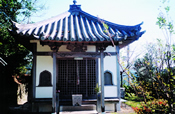
| Click the photo to enlarge it |
|
Jyuo-do
Three Jizo, Enma-daio, Kusyo-jin, and Doso-shin are deified in Jyuo-do. It is carved ‘made in 1702’ on Kusyo-jin. It is told that Enma Jizo was brought from Kyoto. That Jizo was taken when Shrine Merger Oder was advocated in Meiji era, but it was returned by pretext to pray for rain at the drought in the summer of 16th year of Meiji Era. It is told that people received rain by dedicating it in the yard and washing it. |
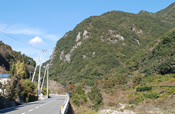
| Click the photo to enlarge it |
|
Takanosu-jo Castle Ruins
On the west of Mt. Takao, over the precipitous cliff facing on Kizekkyo valley, there was Takanosu-jo castle. Saemon Suketoshi, a grandchild of Aisu Hachiro Genkeisin the Seventh, the lord of Kinugasa-jo castle, supported the Southern Dynasty and built the castle, and became the lord of the manor of Shimo and Kami Akizu. In 1585, he was subjugated by Sugiwaka Echigomori at Hedeyoshi’s attack of Kisyu. The castle was burned down and he disappeared. |
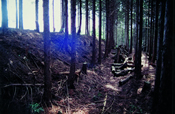
| Click the photo to enlarge it |
|
Okahata-jo Castle RuinsIn 1190, Shioya Saburo, the vassal of Minamoto-no-Yoritomo, built a castle on the top of Nagase-kyo. Yukihisa, the lord of castle, was the founder of Homan-ji Temple on Mt. Iwakura-yama. |
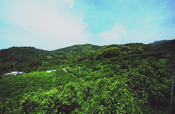
| Click the photo to enlarge it |
|
Kochi-jo Caste Ruins
From the gate of Sakodani, Mt. Kochi-yama is on the left side of Mt. Ryuzen-san as you face it, and it was mentioned that “there is Kochi-jo castle ruins on the mountain of tiger direction from the village, east and west twenty Ken, south and north fifty three Ken” on Kii Fudoki (description of regional climate, culture, etc.). The castle podiums are remained, but the lord of the castle is unknown. In addition, a lot of unglazed earthenware and some stone axes were excavated from the castle ruins during cultivating the land, therefore it could be a site of ancient people’s residences, and it is still a mystery mountain.
。 |
|
Shop manager's selected information
Five minutes from famer's market 'Kitera,' there is Akizuno Garten, a facility connecting urban and local agriculture community, formed with reusing the local elementary school.
It is a popular facility and about 70,000 people visit here in a year.
TEL 0739-35-1199
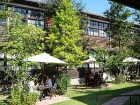
'Valencia Batake', the sweets workshop using citrus fruits harvested in the area, is very
popular. Why don't you stop by and try making sweets for mementos of visiting
the country of Akizuno?
TEL 0739-35-1187

|

 It is about ten minutes from Kitera by car. There is the farmer's restaurant, 'Mikan Batake' in Akizuno Garten. Local mothers make slow food lunch buffet with local fresh vegetables, and it is very popular.
It is about ten minutes from Kitera by car. There is the farmer's restaurant, 'Mikan Batake' in Akizuno Garten. Local mothers make slow food lunch buffet with local fresh vegetables, and it is very popular. 





















